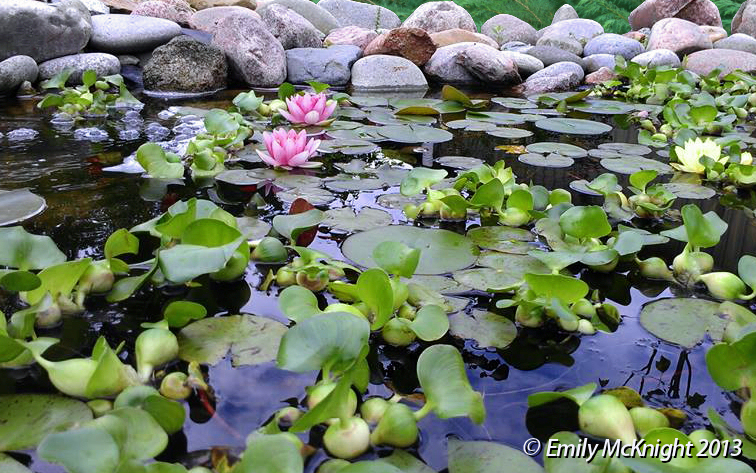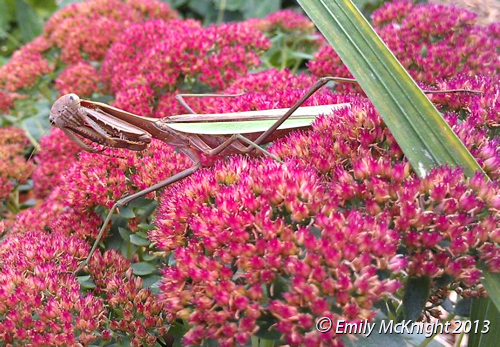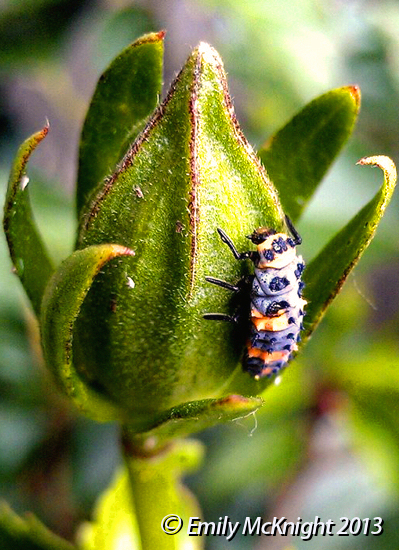Services
Choosing a Service
We offer many services and areas of consultation to help you accomplish the goals you have for your landscape and garden. The main categories of services are listed in the navigation bar on the left, visible from any page. Of course, there is a great deal of overlap between and among these categories, as the garden comprises a combination of different aspects, so there are links throughout this page to connect you to associated concepts.
Landscape Design
Whether you're looking to create a bold new theme, rein in an untidy or troublesome area, or simply expand upon a successful concept on your property, we can offer landscape designs to meet almost any specification. We welcome small and large projects alike, and guarantee that the plants we propose will be well-suited to local conditions and your priorities. Furthermore, all material we install will be professionally planted and provided the followup care needed to ensure that it becomes successfully established to thrive in its new setting. You may purchase a plan alone, or save on the cost of the design by selecting the Landscape Design and Thrive package, which includes the design, our professional planting services to install all plant material, and followup visits to your property to monitor the health of the plants until they are established. We can work with existing plans, or design something completely new based on your requirements and desires. Tell us what your priorities are, and we will share our knowledge and creativity to design the perfect installation for your special space.
- Low Maintenance
- Drought- and Heat-Tolerant Plants
- Native Plants
- Rain Garden
- Perennial Swale
- Xeriscape
- Butterfly Garden
- Color Palette
- Four-Season Interest
- Attracting and Supporting Wildlife
Maintenance
Our focus on the appearance of your property and the health of your plantings will surpass your expectations. During scheduled visits to touch up ornamental plantings, flower beds, and hedges, our treatments keep your plants looking lush and green, and keep the weeds at bay, so that your landscape remains attractive, and preserves an inviting atmosphere for your enjoyment. From spot weeding and pruning, to mulching paths and trimming borders, our attention to detail will keep your property looking its best, freeing up your time to enjoy your surroundings.
Proper landscape maintenance requires timely treatments based on your location, choice of plant material, and seasonal conditions. Any or all of the following topics and services may be of interest to you in your garden.
- Pruning
- Soil Improvement
- Mulching
- Fertilization
- Weatherizing Treatments
- Organic Solutions
- Native Plants
- Pest Management
- Pond Care
- Drip Irrigation
- Storm Cleanup
- Vacation Care
Plant Health
To ensure that the plants in your garden not only survive, but continue to thrive and delight, attention must be paid to the local environmental conditions and selection of appropriate plant material. From light and soil quality requirements, to proper pruning and monitoring for disease and pests, plant health is an essential component of our comprehensive maintenance program.
Much of a plant's likelihood of thriving is determined by proper placement and soil quality. Blooming perennials and shrubs require different soil nutrient profiles than foliage plants and groundcovers, and their displays may underwhelm if soil is nutrient deficient. Certain shrubs require narrow pH ranges to perform well, and if good soil quality is not maintained, plants may suffer or succumb to disease or pests. We take into consideration a number of parameters in our assessment of growing conditions and disease and pest monitoring.
- Organic Solutions
- Pest Management
- Soil Improvement
- Pruning
- Fertilization (regimens tailored to species-specific requirements)
- Mulching (hardwood, softwood, or specialty materials such as pine, shell, or rock)
Container Presentation
Potted arrangements around the garden provide limitless options for artistic expression with living sculpture. From window boxes of bright, colorful annuals, to ceramic planters of delightfully textured foliage, the elegant placement of containers around your home add a finishing touch to complement and elevate the appearance of your landscape.
In addition to adding beauty and interest to your surroundings, containers provide functional opportunities, as well. Hanging baskets of lantana or salvia bring hummingbirds and butterflies delightfully close to your windows for viewing, while sunny window boxes of specialty herbs provide fresh culinary opportunities for epicurean enthusiasts. Keep a few tomato and pepper plants on the patio next to a potted lime tree for summer salsa parties!
There are varieties of annuals and perennials suitable for bringing to life any sunny or shady area, and Emily is pleased to offer her artistic touch and extensive knowledge of plant performance in customizing your containers, planters, and baskets to enhance and beautify your environment. Consider the benefits of container gardening, and let us help you use attractive arrangements to accomplish your needs:
- attract butterflies and hummingbirds for close viewing
- provide beautiful backdrops for parties and family photos
- grow herbs and vegetables for fresh salads and cooking
- create a pleasant setting around your outdoor seating area
- obscure awkward corners or unsightly areas with lush, attractive displays
Pruning
Pruning can improve the appearance of any neglected or overgrown ornamental tree or shrub, by encouraging new growth to rejuvenate the plant so that it produces lush foliage. The timing and execution of pruning operations also affects the production of flowers and fruits. Professional pruning service will maximize the blooming potential of ornamental trees and flowering shrubs, as well as the fruiting capacity of berry bushes and orchard trees.
However, the benefits of pruning go far beyond the aesthetics of your landscape. Proper pruning, precisely timed, can prevent the development and spread of disease, protect against infection, and even minimize the chance of wind and storm injury by removing weak and damaged sections of wood.
- removal of damaged, diseased, and dead branches
- maximizing bloom potential of flowering trees and shrubs
- removal of low-hanging branches for convenience and safety
- rejuvenation of older trees and shrubs
- establish attractive borders and define natural spaces
- strategic thinning to improve size, shape, and appearance
- maximize fruit production of berry bushes and fruit trees for greater harvests
Pond Care
Ponds and water gardens are living ecosystems, requiring knowledgeable care and regular monitoring to remain healthy and beautiful. We cater our services to your specific aquatic system and its inhabitants. Once a healthy biological cycle is established, maintaining readings within safe parameters is simple and will ensure that your aquascape requires minimal intervention and offers maximum enjoyment.

The most critical times of the year are the spring and fall clean-out sessions, to prepare the system for transitions of temperature and nutrient load. We offer thorough and professional cleanings for spring and fall, as well as the following services:
- Clean pumps and replace filtration media
- Anticipate and address common issues of recently-established or newly-stocked ponds
- Amend environmental conditions that contribute to overgrowth of algae
- Monitor water quality and chemistry, and treat imbalances before they escalate and threaten aquatic life
- Diagnose and treat fish diseases and other environmental concerns
- Seasonally stock ponds with fish, plants, and invertebrates
- Maintain pond and feed fish during vacations or absence
- Recommend pond and water garden designs and modification
Edible Gardening
Whether your passion is putting fresh, homegrown food on your table, or providing an inviting environment to shelter and feed local wildlife throughout the seasons, we can provide guidance and ideas to maximize the output of your yard, and increase the value of your landscape. Emily has extensive experience planting, growing, and troubleshooting edible plants, from in-ground vegetable gardens to growing food in compact spaces and in containers on balconies.
Incorporating companion planting techniques into these arrangements can maximize flavor and output on any scale of edible gardening operation while minimizing pest damage by encouraging natural, beneficial insects and deterring undesirable insects and other pests.
Organic Solutions
We advocate the use of natural and organic products and amendments whenever possible. By minimizing the toxic synthetic residues in your garden, we promote the health and safety of your family and pets as well as protecting the local environment. With extensive training, experience, and product knowledge, we can help you accomplish the goals you identify using natural materials and cultural methods.

|
Synthetic fertilizers, pesticides, and herbicides negatively impact local wildlife and water supply. Natural and organic treatments can alleviate many issues that arise from the use of broad-spectrum and non-specific synthetic pesticides, and often eliminate the need for their use entirely. Synthetic treatments often have unintentional, negative consequences that are both far-reaching and persistent, and often require followup interventions and continued controls when the natural balance of the garden is upset by the use of these treatments. Many synthetic chemical solutions used for pest control leave toxic residues for days or even weeks, poisoning beneficial insects and desirable wildlife, and create conditions that encourage the re-infestation by the target pests by eliminating the populations of natural predators. |
Most pest problems can be prevented, managed, or eliminated without the use of harmful products. Whenever possible, we advocate the use of specific, targeted treatments to address only the problem condition or organism, with minimal residual impact on non-target species, such as the butterflies, bees, birds, people, and pets that visit your garden.
When situations warrant the use of synthetic treatments or controls, we practice carefully controlled applications, following label guidelines and adhering to safety protocols.

|
Pest ManagementEven under ideal conditions, pests can become a problem in the garden if untreated. If left to languish, these situations can escalate into widespread and unsightly damage to shrubs, trees, and edible plants. Pest and disease damage can negatively impact the appearance of your landscape, and reduce the quality and yields of your harvest. We practice a proactive approach to pest management, including preventative and pre-emergent treatments, as well as comprehensive post-emergent monitoring and management protocols, if issues arise. We recognize the importance of acknowledging “the big picture;” your garden is an ecosystem that is always in flux. With proper monitoring and a healthy diversity of plants, many problems will be self-corrected by the presence of beneficial insects that naturally prey upon the target pests. When intervention is necessary, we offer both organic and synthetic treatments to manage infestations and protect your investment.
|
Soil Improvement
Every plant in your garden needs three things to survive: light, moisture, and nutrients. Of these three, it is only nutrients that are completely within your control, by defining soil quality. Because soil quality also dictates the interaction of your plants with the water in their environment, it goes a long way to determining the success of your landscape. Soil can create problems for less drought-tolerant plants if it drains too rapidly, and for property as well as plants if it drains too slowly, causing water to wash out slopes or pool in low areas. Additionally, if the nutrient profile of the soil is either too rich or deficient, it can severely limit the options of available plant material that will thrive.
In our region, most of the native soil contains an abundance of clay. Soils high in clay content have the benefits of being able to hold plenty of water and nutrients, and a high capacity to buffer pH. Sufficiently aggregated clay soils also resist wind and water erosion better than sandy soils. However, the unique nature of clay also creates associated challenges, including poor aeration and drainage, high compactability, and slow warming in the spring. These are the considerations we keep in mind when recommending soil amendments for your planting areas.
Soil structure and texture affects aeration, water movement, heat conduction, erosion resistance, nutrient density and root growth. The addition of organic material and coarse mineral content improves soil texture by breaking up dense clay to improve these factors.
At the sub-cellular scale of soil composition, soil particle aggregation is increased by the sticky polysaccharides exuded by fungi and bacteria as they consume organic content. Thus the introduction of organic material such as compost and peat into soil helps maintain an active, “living” soil which contributes naturally to the formation of desirable soil structure. Organic material also provides steady and gradual nutrient release to plants throughout the growing season.
- Amendments to improve long-term soil quality (including compost, peat moss, manure, perlite, vermiculite, sand)
- Organic Solutions
- Plant Health
- Mulching with hardwood, softwood, or specialty materials such as pine, shell, or rock
- pH correction treatments (lime, sulfur, gypsum)
- Soil fertility tests (nitrogen, phosphorus, potassium)
- Natural and synthetic fertilizers available (regimens tailored to species-specific requirements)
- Specialty soil treatments (including compost tea and mycorrhizae inoculant)
Native Plants
With all of the available cultivars of annuals and perennials to choose from, it is easy to be swept away by all the flashy new designs that plant breeders develop to showcase at garden centers and nurseries each year. Of course, every plant bred and designed for sale to gardeners began with a “native” plant from somewhere on the planet, although many hail from regions of the world with distinctly different climate, growing seasons, and wildlife. While they may look gorgeous on racks at the nursery, these new botanical creations were developed under controlled conditions, often in fully-irrigated and -fumigated nurseries treated chemically for pests, and may require very specific care in order to survive Iowa droughts, winters, and the appetites of our indigenous critters.
Survivability
Native plants, on the other hand, have evolved in concert with local wildlife, pollinators, and pests, and are therefore the standout survivors in our gardens with little to no intervention necessary. Once fully established (usually 2-3 years of supportive watering when needed), native Iowan prairie plants are completely drought-resistant and need no supplemental watering, due to their superior root systems and other distinguishing characteristics to slow transpiration. By contrast with turfgrass and many introduced and cultivated decorative annuals and perennials, which have root systems measured in mere inches, Midwest native plants have root networks capable of accessing water deep within the earth. Fully established prairie plants may have root systems extending as deep fifteen feet below the soil's surface. These expansive root masses are a hallmark adaptation of prairie plants, constituting two-thirds of the total biomass of these perennial survivors.
Soil Improvement
A further adaptation of native plants to living in our region is their ability to actively improve the soil quality in their vicinity. Prairie grasses and sedges, in particular, naturally shed up to 33% of their root masses each year. As these plant tissues decompose underground, they add organic matter to the soil, thereby increasing the soil's moisture-holding capacity. The improved water absorption of these enriched soils guards against runoff, flooding, and erosion from periodic heavy rains.
Wildlife Habitat
Despite all the activity we see at our busy bird feeders, over 95% of our birds raise their young primarily on insect diets, relying on the preservation of habitats suitable for supporting the insects on which they prey. While adult seed- and fruit-eating birds can find food at our feeders and fruiting plants, their young can only be raised in areas where the local plant material supports a variety of (mostly larval) insect populations. Even the hummingbirds that delight us in the spring and summer as they hover in our gardens rely heavily on the protein, vitamin, and mineral content of tiny insects to augment the nutritionally empty nectar portion of their diet. As a general rule, native insects are attracted only to native plants; likewise, native birds can eat only native insects. In addition, during the cold winter season, the insects and their eggs overwintering in the plant material of our gardens provide a food source for our winter resident birds. Without adequate protein provided by the insects in your garden and surrounding areas, only seed-eating birds can survive.
- Support sustainable ecology
- Soil Improvement
- Simple to propagate
- Wind, heat, drought, and disease resistant
- Low-maintenance
